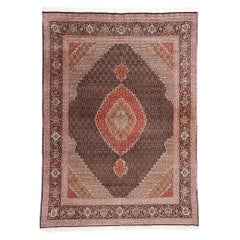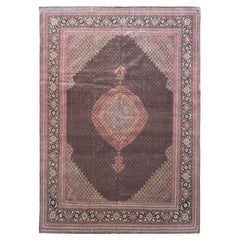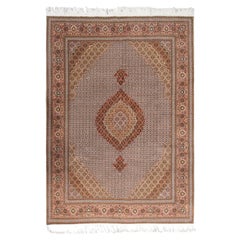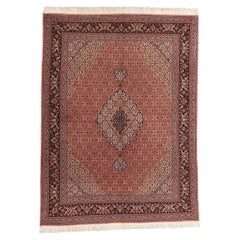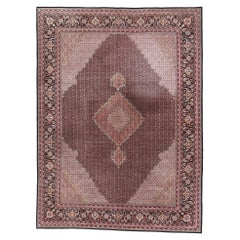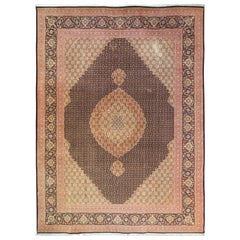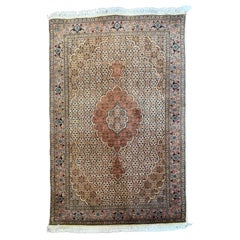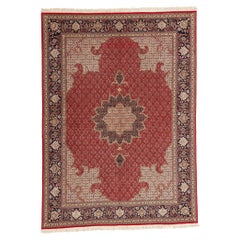Tabriz Mahi Wool And Silk Persian Carpet
Mid-20th Century Persian Tabriz Persian Rugs
Wool, Silk
Late 20th Century Persian Tabriz Persian Rugs
Wool
Mid-20th Century Persian Tabriz Persian Rugs
Wool, Silk
Vintage 1960s Persian Tabriz Persian Rugs
Wool, Silk
Late 20th Century Persian Tabriz Persian Rugs
Wool, Silk
Mid-20th Century Chinese Tabriz Persian Rugs
Wool, Silk
Late 20th Century Persian Tabriz Persian Rugs
Wool
Mid-20th Century Persian Tabriz Persian Rugs
Silk, Cotton, Wool
Late 20th Century Persian Tabriz Persian Rugs
Wool, Silk
Early 2000s Persian Persian Rugs
Wool, Silk
Vintage 1960s Persian Tabriz Persian Rugs
Wool, Silk
Vintage 1970s Persian Tabriz Persian Rugs
Wool, Cotton, Silk
Vintage 1960s Persian Tabriz Persian Rugs
Wool, Cotton, Silk
Early 2000s Persian Tabriz Persian Rugs
Silk
Vintage 1970s Persian Tabriz Persian Rugs
Wool, Cotton, Silk
Early 2000s Persian Tabriz Persian Rugs
Wool, Cotton, Silk
2010s Persian Tabriz Persian Rugs
Wool, Cotton, Silk
Early 2000s Persian Tabriz Persian Rugs
Wool, Cotton, Silk
Mid-20th Century Persian Tabriz Persian Rugs
Wool, Cotton, Silk
Vintage 1960s Persian Tabriz Persian Rugs
Wool, Silk
Vintage 1960s Persian Tabriz Persian Rugs
Wool, Silk
Late 20th Century Persian Tabriz Persian Rugs
Wool, Silk
Late 20th Century Persian Tabriz Persian Rugs
Wool, Silk
Late 20th Century Persian Persian Rugs
Wool, Cotton, Silk
Late 20th Century Persian Persian Rugs
Wool, Silk, Cotton
Late 20th Century Chinese Tabriz Persian Rugs
Wool, Silk
1990s Persian Tabriz Persian Rugs
Wool, Silk
Vintage 1970s Persian Tabriz Persian Rugs
Wool, Cotton, Silk
Late 20th Century Persian Persian Rugs
Wool, Silk
Late 20th Century Persian Persian Rugs
Wool, Cotton, Silk
2010s Indian Tabriz Persian Rugs
Silk
Early 2000s Persian Tabriz Persian Rugs
Wool, Silk
Mid-20th Century Persian Tabriz Persian Rugs
Wool
Early 2000s Persian Tabriz Persian Rugs
Wool, Cotton, Silk
Antique 1880s Persian Heriz Serapi Persian Rugs
Wool
Early 2000s Persian Tabriz Persian Rugs
Wool, Cotton, Silk
Early 2000s Persian Tabriz Persian Rugs
Wool, Cotton, Silk
Vintage 1970s Persian Tabriz Persian Rugs
Wool, Cotton, Silk
Early 20th Century Persian Tabriz Persian Rugs
Wool
Vintage 1960s Persian Tabriz Persian Rugs
Wool
Mid-20th Century Persian Tabriz Persian Rugs
Wool, Silk
Early 20th Century Persian Tabriz Persian Rugs
Wool
Vintage 1960s Persian Tabriz Persian Rugs
Wool, Cotton
Vintage 1970s Persian Tabriz Persian Rugs
Wool, Silk
Late 20th Century Chinese Regency Revival Persian Rugs
Wool
Late 20th Century Persian Persian Rugs
Wool
20th Century Persian Tabriz Persian Rugs
Silk, Wool
Vintage 1970s Persian Tabriz Persian Rugs
Wool, Cotton, Silk
Vintage 1910s Persian Tabriz Persian Rugs
Wool, Cotton
Vintage 1910s Persian Tabriz Persian Rugs
Wool, Cotton
Antique Late 19th Century Persian Tabriz Persian Rugs
Wool, Cotton
20th Century Persian Persian Rugs
Wool, Cotton
2010s Indian More Carpets
Silk
21st Century and Contemporary Pakistani Central Asian Rugs
Wool, Cotton, Silk
2010s Indian Tabriz More Carpets
Silk
2010s Indian Tabriz More Carpets
Silk
2010s Indian Tabriz More Carpets
Silk
2010s Indian Tabriz More Carpets
Silk
- 1
Tabriz Mahi Wool And Silk Persian Carpet For Sale on 1stDibs
How Much is a Tabriz Mahi Wool And Silk Persian Carpet?
A Close Look at Tabriz Furniture
Tabrīz rugs and carpets are named for their place of origin — the northwestern Iranian city of Tabrīz (or Tabriz). To collectors of antique and vintage Persian carpets and rugs, it is one of history’s best-known hubs for textiles and other handicrafts. Tabriz is among the most populous cities in Iran and home to a rich tradition of hand-knotted rugs. The region’s weavers and their craft flourished under the Safavid dynasty between the 12th and 16th centuries after the Safavids wrested control of the city from the Turks.
Aside from asymmetrical knots, the characteristics of antique Tabriz rugs and carpets include intricate patterns and designs woven from silk and wool. (Antique rugs are primarily woven from the latter.) Like Turkish rugs, Tabriz and other Persian rugs often reflect the region where they were made and typically feature floral and garden motifs with bold maroon, gold and red palettes. The most iconic motif found in Tabriz rugs is a central medallion that radiates outward into other star-shaped pendants and cartouches, with quarter medallions positioned on the corners, while special variations feature curling arabesque floral motifs and hunting scenes. There are rich hues of ivory, copper, terracotta and burgundy with complementing highlights of navy blue and deep green.
While weavers traditionally rely on their fingers to produce the knots in Persian rugs and carpets, local weavers in Tabriz utilize a knife with a buttonhook-like projection to increase their speed. Some of the region’s artisans have set records for weaving faster than one knot per second. These rugs feature an integration of knots that are both Persian and Turkish in origin, and have a double weft made with cotton, wool or silk and cotton warps. This unique process makes these textiles the product of one of the finest and most delicate rug-making traditions in the world.
Tabriz carpets, along with other types of Persian rugs, have experienced a contemporary revival in the past few decades and are a coveted and distinctive piece of craftsmanship in many homes and other interior spaces.
Find a collection of antique and vintage Tabriz rugs and carpets, wall decorations and other furniture on 1stDibs.
Finding the Right Rugs And Carpets for You
Good antique rugs and vintage rugs have made their way into homes across the globe, becoming fixtures used for comfort, prayer and self-expression, so choosing the right area rug is officially a universal endeavor.
In modern usage, “carpet” typically denotes a wall-to-wall floor cushioning that is fixed to the floor. Rugs, on the other hand, are designed to cover a specific area and can easily be moved to new locations. However, the terms are interchangeable in many parts of the world, and, in the end, it won’t matter what you decide to call it.
It’s well known that a timeless Persian rug or vintage Turkish rug can warm any interior, but there are lots of other styles of antique rugs to choose from when you're endeavoring to introduce fresh colors and textures to a bedroom or living room.
Moroccan Berber rugs are not all about pattern. In fact, some of the most striking examples are nearly monochrome. But what these rugs lack in complexity, they make up for in brilliant color and subtle variation. Moroccan-style interiors can be mesmerizing — a sitting room of this type might feature a Moroccan rug, carved wooden screens and a tapestry hung behind the sofa.
Handwoven kilim rugs, known for their wealth of rich colors and unique weaving tradition, are pileless: Whereas the Beni Ourain rugs of Morocco can be described as dense with a thick surface or pile, an authentic kilim rug is thin and flat. (The term “kilim” is Turkish in origin, but this type of textile artistry is practiced all across the Balkans, throughout the Arab world and elsewhere.)
When it comes to eye-catching floor coverings, the distinctive “medallion” pattern of Oushak rugs has two types of rounded shapes alternating against a rich red or blue background created with natural dyes, while the elaborate “star” pattern involves large eight-pointed shapes in diagonal rows alternating with diamonds.
If you’re looking for something unexpected, find a runner rug that pops in your hallway or on your stairs. Dig for dazzling geometric patterns in our inventory of mid-century modern rugs and carpets, which includes works designed by the likes of Swedish textile masters Märta Måås-Fjetterström, Marianne Richter and other artisans.
Carpets and rugs have been around for thousands of years. Prehistoric humans turned to animal skin, wool and fur to craft simple fabrics to soften hard terrain. A 2016 study suggests that "cave lions" were hunted for exactly this purpose, and that decorating your cave with their pelts may have conferred strength and prestige. Although many of these early textiles are still in existence, tracing their precise origins is difficult. Carpets quickly became such a valuable trade commodity that the weavings could easily travel far from their places of origin.
The oldest known carpet was found in southern Siberia. (It may have traveled there from Persepolis in Iran.) For the flat-weave floor rugs crafted by Native Americans, cotton was the primary material before sheep’s wool was introduced in the 16th century. In Europe, carpet-making was fundamental to folk art, and Asian carpets imported to European countries were at one time considered a precious luxury and not intended to remain permanently on the floor.
With the variety of area rugs and carpets rolled out for you on 1stDibs — a collection that includes traditional, modern, minimalist rugs and other coverings of all kinds — things will be looking up whenever you’re looking down.
